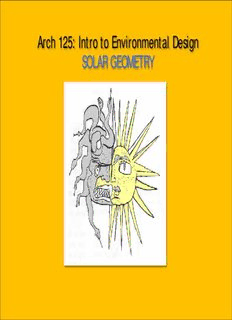
Arch 125: Intro to Environmental Design SOLAR GEOMETRY PDF
Preview Arch 125: Intro to Environmental Design SOLAR GEOMETRY
Arch 125: Intro to Environmental Design SOLAR GEOMETRY Texts used in the preparation of this presentation. There are large numbers of buildings that treat windows as patterning devices, and that do not take advantage of the sun in obvious ways. In fact, the windows at the right ARE Morse Code. …time of day affects windows... Antoine Predock: Alumni Reception Hall, University of Minnesota In studying Solar Geometry we are going to figure out how to use the sun’s natural path in summer vs. winter to provide FREE heat in the Winter, and to reduce required COOLING in the summer. Differentiating Passive vs. Active Design Passive design results when a building is created and simply works “on its own”. The plan, section, materials selections and siting create a positive energy flow through the building and “save energy”. Active design uses equipment to modify the state of the building, create energy and comfort; ie. Fans, pumps, etc. Passive buildings require active users (to open and shut windows and blinds…) 6 main strategy modes for PASSIVE design GO TO PSYCHROMETRIC CHART TUTORIAL! tboake.com/sustain_casestudies/PsyChart.html We use this chart to determine when we DO and DO NOT want sun penetration in and around our buildings. Understanding solar geometry is essential in order to: • do passive building design (for heating and cooling) • orient buildings properly • understand seasonal changes in the building and its surroundings • design shading devices • use the sun to animate our architecture Solar geometry works for us because the sun is naturally HIGH in the summer, making it easy to block the sun with shading devices. And it is naturally LOW in Winter, allowing the sun to penetrate below our shading devices and enter the building - with FREE heat.
Description: